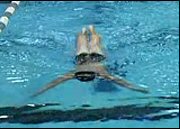10/20/04 Stay Low On Butterfly!
by Glenn Mills
Premium Members
- Click Here to Download Bonus Video Clip (Windows Media Player Format 1.6MB)
Premium Members
- Click Here to Download Bonus Video Clip (Quick Time Format 1.8MB)
Most swimmers spend too much time diving WAY DOWN and then climbing WAY UP when
they swim butterfly. Low Fly helps you stay in the speed zone – staying nice
and low as your breathe and sweep your arms over the surface, and staying
shallow as you glide and kick. Low Fly helps you send your energy FORWARD – not
up and down – when you swim fly.
How To Do It:

|
1. Push off the wall in streamline and pulse 3 or 4
times, using a full-body dolphin motion to send you forward.
|

|
2. On the 3rd pulse, send your hands out to the
corners (about shoulder width apart), grab on to the water, and pull it back
into your sternum (chest).
|

|
3. From the sternum, push the water OUT TO THE SIDE
and sweep your arms out and over the water.
|

|
4. Land your hands and arms softly and send them
FORWARD, not down.
|

|
5. Pulse 3 or 4 times in streamline, then repeat.
|
How To Do It Really Well (the Fine Points):
Let’s go to the video tape.
-
Look down when you breathe. Watch how this swimmer keeps his eyes focused down
at the water when he breathes.
-
Take a QUICK breath. Start the breath as soon as you start the pull, and get
your face back in the water as you recover the arms.
-
Keep your arms low and skim them just over the surface of the water. Lead with
the back of the wrist. Pretend you are wearing a wristwatch on each arm, and
lead with the face of the watch.
-
Send your body and your energy FORWARD, not up and down. Rise just over the
surface for the breath and recovery. Skim just under the surface for the glide
and kick.
Troubleshooting:
-
Can’t get the timing? If you feel really uncoordinated, you may be pushing too
far back with your hands and arms. Instead of pushing BACK, push your arms OUT
and to the sides – kind of like a sideways karate chop. This gives you a faster
recovery, and will keep your arms from getting “hung up” at your hips.
-
Totally exhausted after a few strokes? Put on fins! Fins will help you learn
the pulsing (slinky) motion that is key to a good butterfly. They will also
help you maintain your form, so that you can build up your “butterfly muscles”
without struggling.
-
Still exhausted? Try taking just 1 or 2 pulses between each stroke – rather
than 3 or 4.
|